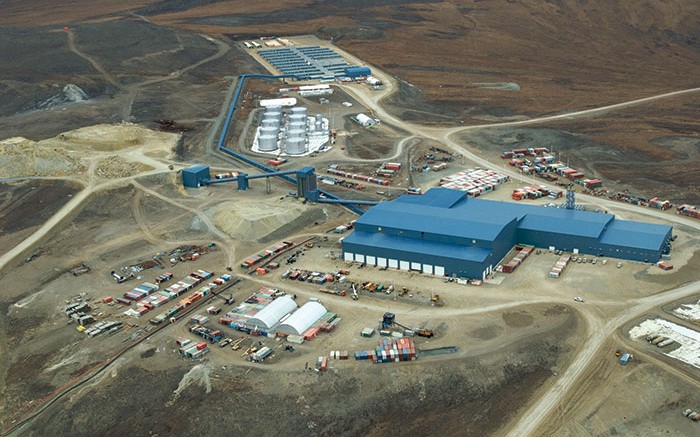Citing Kinross Gold’s (TSX: K; NYSE: KGC) higher costs and its “operating risk exposure” in Russia, Standard & Poor’s has lowered the Toronto-based gold producer’s long-term corporate credit rating to BB+ from BBB-.
“We expect the company’s competitive position to remain weaker than its investment-grade peers over the next two years, which primarily reflects Kinross’ comparatively higher-cost structure,” the ratings agency said in a statement.
“In addition, we expect that the company’s profitability will remain highly reliant on Kinross’ low-cost Russian operations [Kupol/Dvoinoye] at least over the next year, which contribute to operating risk exposure that we no longer consider commensurate with a ‘BBB-’ rating.”
The downgrade comes several days after Kinross reported a fourth-quarter net loss of US$841.9 million, or US73¢ per share. The loss includes a non-cash, after-tax impairment charge of US$430.2 million related to property, plant and equipment, and a writedown of inventory and other assets of US$235 million. For the year, Kinross posted a net loss of US$984.5 million, or US86¢ per share.
The gold miner produced 2.6 million oz. gold last year at all-in sustaining costs (AISC) of US$975 per oz., and forecast that 2016 production should range from 2.7 to 2.9 million oz. gold at US$890 to US$990 per oz. AISC.
Since it began a major review of mining companies on Jan. 29, S&P has downgraded Freeport-McMoRan (NYSE: FCX), Teck Resources (TSX: TCK.B; NYSE: TCK) and Anglo American (US-OTC: NGLOY; LSE: AAL) by two notches, the first two with a ‘negative’ outlook and the third with a ‘stable’ outlook. It has also downgraded Vale (NYSE: VALE), Glencore (LSE: GLEN) and BHP Billiton (NYSE: BHP) by one notch, while placing BHP on credit watch with negative implications.
“The rating downgrades are a predictable and expected part of this cycle … as evidenced by the equity market’s non-reaction,” analysts at London-based Investec Securities wrote in a Feb. 19 research note.
As for Kinross, S&P’s downgrade “follows the change in our assessment of the company’s business risk profile to ‘fair’ from ‘satisfactory,’” Standard & Poor’s credit analyst Jarrett Bilous stated.
S&P also said that its “stable outlook” rating for the company reflected its view that Kinross “will generate adjusted debt to earnings before interest, taxes, depreciation and amortization in the mid-2x area over the next 12 months, which we believe is sufficient for the company to maintain an intermediate financial risk profile. We also expect Kinross to generate at least break-even free operating cash flow over the next two years, based on an average gold price of US$1,100 per ounce.”
In an email response to questions, Louie Diaz, senior manager of corporate communications for Kinross, told The Northern Miner that management believes Kinross is in a strong financial position, and noted the company has met its cost guidance for the last four years.
“In 2015, we achieved the lowest cost of sales since 2011, and we expect to lower our AISC in 2016,” Diaz said. “We have also made prudent cost assumptions for FX and oil, and expect to benefit if levels remain or weaken further.” He adds that the company took “advantage” of a strong balance sheet last year “to acquire quality producing assets in Nevada — one of the most mining friendly jurisdictions in the world — which are expected to increase cash flow, enhance credit metrics, add to production and lower our cost profile.”
As for S&P’s reasoning that Kinross is “highly reliant” on Russia operations, Diaz countered that this year the company expects production from its diversified mine portfolio will break down in the following way: the Americas region to increase to 61% (from 54%), the West Africa region to decrease to 14% (from 17%) and the Russia region to decrease to 25% (from 29%).
“We have operated in Russia for the past 20 years without interruption, and have strong relationships with all levels of government,” Diaz added.
When Kinross announced its fourth quarter and year-end results for 2015, president and CEO J. Paul Rollinson also noted his firm has consistently met its guidance targets, kept a strong balance sheet and produced 10 million oz. gold over the last four years.
“Looking forward over the next four years,” Rollinson said, “we expect to produce another 10 million oz. gold, and intend to maintain the same record of operational dependability and balance sheet strength.”
Last year the company paid down debt by US$80 million. Apart from US$250 million in senior notes, which are scheduled to be repaid by September 2016, Kinross has no debt maturities until 2019.
As of Dec. 31, 2015, Kinross had cash and equivalents — excluding restricted cash — of US$1,043.9 million, in a $60.4-million increase since Dec. 31, 2014.
The company also had available credit of US$1,506 million as of year-end 2015.
After acquiring Bald Mountain in January — which includes one of the largest land packages in Nevada — and 50% of Round Mountain from Barrick Gold (TSX: ABX; NYSE: ABX) for US$610 million in cash, Kinross had cash and equivalents of US$600 million and US$1.3 billion in available credit.


Be the first to comment on "Kinross credit rating cut to ‘junk’"